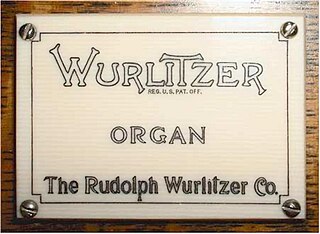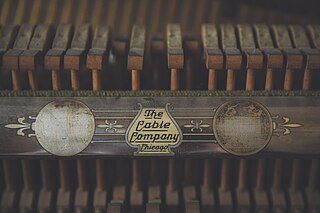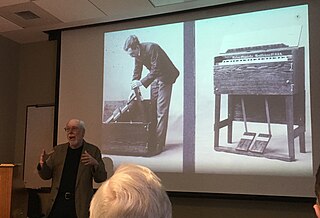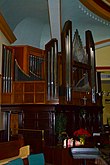
In music, the organ is a keyboard instrument of one or more pipe divisions or other means for producing tones. The organs have usually two or three, up to five, manuals for playing with the hands and a pedalboard for playing with the feet. With the use of registers, several groups of pipes can be connected to one manual.

A free reed aerophone is a musical instrument that produces sound as air flows past a vibrating reed in a frame. Air pressure is typically generated by breath or with a bellows. In the Hornbostel–Sachs system, it is number: 412.13. Free reed instruments are contrasted with non-free or enclosed reed instruments, where the timbre is fully or partially dependent on the shape of the instrument body, Hornbostel–Sachs number: 42.

Brattleboro, originally Brattleborough, is a town in Windham County, Vermont, United States, located about 10 miles (16 km) north of the Massachusetts state line at the confluence of Vermont's West River and Connecticut. With a 2022 Census population of 12,106, it is the most populous municipality abutting Vermont's eastern border with New Hampshire, which is the Connecticut River.

Rodgers Instruments Corporation is an American manufacturer of classical and church organs. Rodgers was incorporated May 1, 1958 in Beaverton, Oregon by founders, Rodgers W. Jenkins and Fred Tinker, employees of Tektronix, Inc., of Portland, Oregon, and members of a Tektronix team developing transistor-based oscillator circuits. Rodgers was the second manufacturer of solid state oscillator-based organs, completing their first instrument in 1958. Other Rodgers innovations in the electronic organ industry include solid-state organ amplifiers (1962), single-contact diode keying (1961), reed switch pedal keying for pedalboards (1961), programmable computer memory pistons (1966), and the first MIDI-supported church organs (1986).

An electric organ, also known as electronic organ, is an electronic keyboard instrument which was derived from the harmonium, pipe organ and theatre organ. Originally designed to imitate their sound, or orchestral sounds, it has since developed into several types of instruments:

The Rudolph Wurlitzer Company, usually referred to as simply Wurlitzer, is an American company started in Cincinnati in 1853 by German immigrant (Franz) Rudolph Wurlitzer. The company initially imported stringed, woodwind and brass instruments from Germany for resale in the United States. Wurlitzer enjoyed initial success, largely due to defense contracts to provide musical instruments to the U.S. military. In 1880, the company began manufacturing pianos and eventually relocated to North Tonawanda, New York. It quickly expanded to make band organs, orchestrions, player pianos and pipe or theatre organs popular in theatres during the days of silent movies.

The pump organ or reed organ is a type of organ using free-reeds that generates sound as air flows past the free-reeds, the vibrating pieces of thin metal in a frame. Specific types of pump organ include the harmonium using pressure system, suction reed organ using vacuum system, and the Indian harmonium; the historical types include the Kunstharmonium and the American reed organ; the earliest types include the physharmonica and the seraphine. The idea for the free reed was derived from the Chinese sheng through Russia after 1750, and the first Western free-reed instrument was made in 1780 in Denmark.

Mason & Hamlin is an American manufacturer of handcrafted grand and upright pianos, currently based in Haverhill, Massachusetts. Founded in 1854, it is one of two surviving American piano manufacturers from the "Golden Age" of pianos, although some smaller piano manufacturers have since started in the United States.

Chord organ is a kind of home organ that has a single short keyboard and a set of chord buttons, enabling the musician to play a melody or lead with one hand and accompanying chords with the other, like the accordion with a set of chord buttons which was originated from a patent by Cyrill Demian in 1829, etc.
Kimball International, Inc. is an American company which consists of furniture brands: Kimball, National, Interwoven, Etc., David Edward, D'Style and Kimball Hospitality. It is the successor to W.W. Kimball and Company, the world's largest piano and organ manufacturer at certain times in the 19th and 20th centuries.

Harald Bode was a German engineer and pioneer in the development of electronic musical instruments.

Levi K. Fuller was an American businessman, military officer, and politician. A Republican, he served in the Vermont Senate from 1880 to 1882, as lieutenant governor from 1886 to 1888, and the 44th governor of Vermont from 1892 to 1894.

The Homestead–Horton Neighborhood Historic District encompasses a small turn-of-the-20th century neighborhood area in Brattleboro, Vermont. Located on a portion of Canal Street and all of Horton and Homestead Places, the district includes a significant number of Queen Anne Victorians, as well as the Italianate home of Jacob Estey, proprietor of the Estey Organ Company, one of the city's larger employers. The district was listed on the National Register of Historic Places in 2009.
St. Paul is a Roman Catholic church in the Glenville section of Greenwich, Connecticut, part of the Diocese of Bridgeport. This is one of the only parishes in Connecticut that also serve parishioners who live in New York.

The Cable Company was an American manufacturer and distributor of pianos and reed organs that operated independently from 1880 to 1936.

Edwin Scott Votey was an American businessman, inventor, industrial designer, and manufacturer of pianos and organs. He worked in the organ field all his adult life and had over twenty patents. He invented or co-invented several inventions for World War I. One was a pilotless airplane that was going to be used to drop bombs on the enemy but was never used.

Hinners Organ Company was an American manufacturer of reed and pipe organs located in Pekin, Illinois. Established in 1879 by German-American John Hinners, the firm grew through several partners, becoming Hinners & Fink in 1881, Hinners & Albertsen in 1886, and Hinners Organ Company in 1902. In the 1920s Hinners established a subsidiary, the Illinois Organ Supply Company, which mass-produced parts for Hinners and other firms. Business declined in the 1930s due to the Great Depression, changing technology, and increasing competition. Hinners became a service company in 1936 and closed in 1942.
William E. Haskell was an American organ-builder and inventor born on November 29, 1865, in Chicago, Illinois. His father, Charles S. Haskell, was also an organ-builder employed by the Roosevelt organ company, located in Philadelphia. At the age of 18, Haskell began working with his father, and around 1901, he established the William E. Haskell Co. of Philadelphia, Pennsylvania. This organ-building firm was later acquired by Estey Organ Co., and Haskell became superintendent of the Estey pipe organ division, which was located in Vermont. He died there on May 13, 1927.

Dennis Waring is a multi-instrumentalist musician, teacher, historian and ethnomusicologist who was the Connecticut State Troubadour from 2003 through 2004. He wrote a history book on the Estey Organ Company titled Manufacturing the Muse: Estey Organs & Consumer Culture in Victorian America, based on his 1987 doctoral dissertation at Wesleyan University, where he was curator of a world instrument workshop while a graduate student.
R. S. Williams & Sons was musical instrument manufacturing company headquartered in Toronto, Ontario with a factory located in Oshawa, Ontario.


































